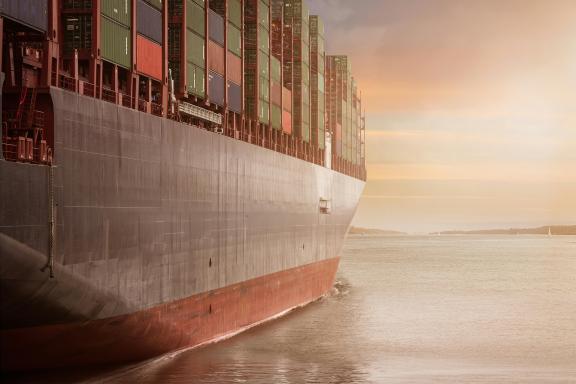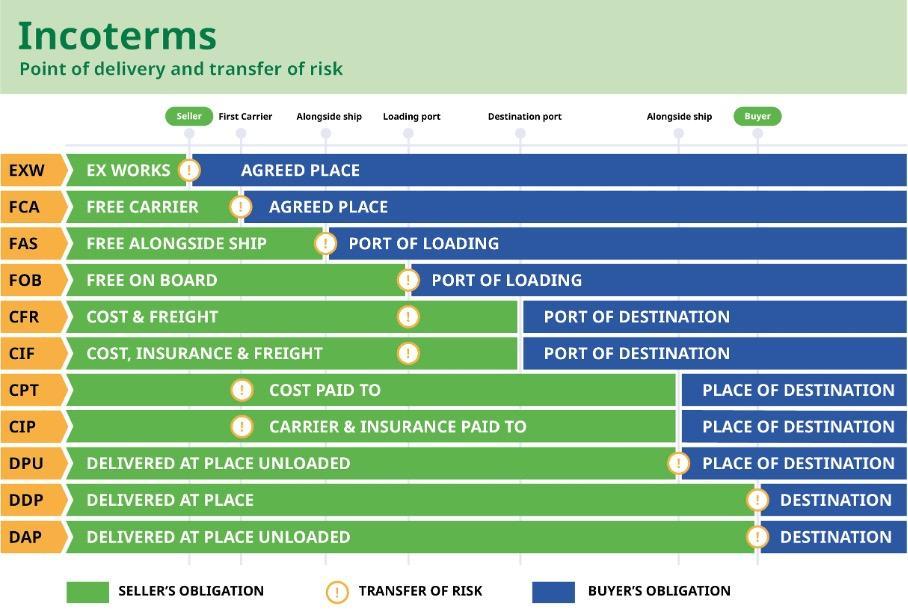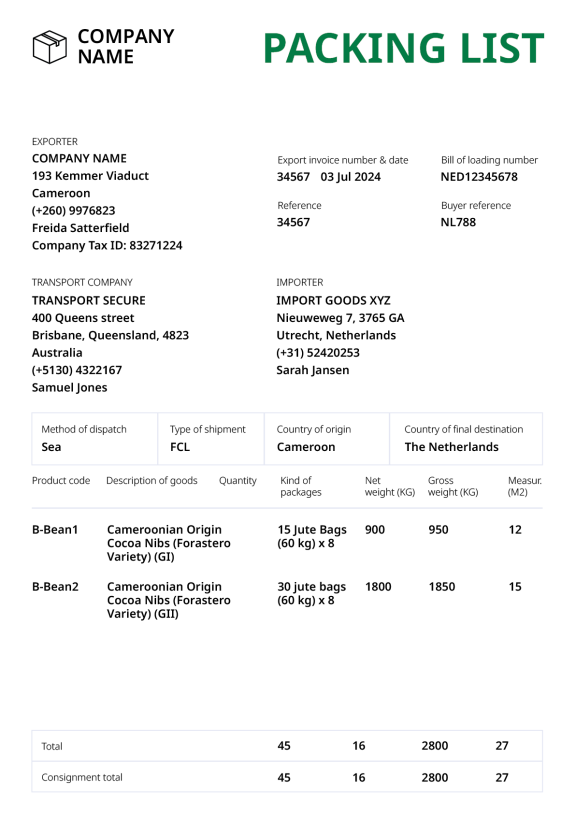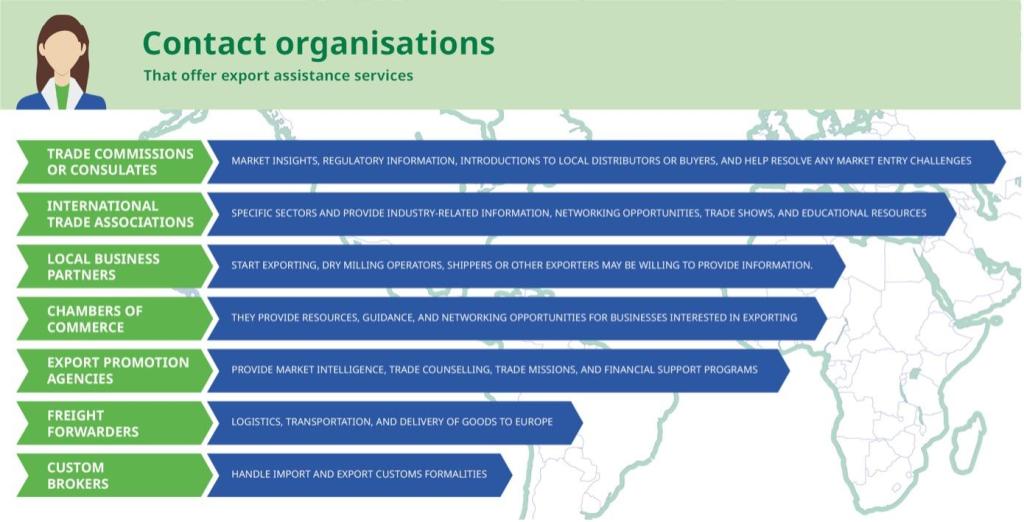10 tips on how to organise your cocoa export to Europe
It is crucial to have a good understanding of practical export processes in order to become and remain a successful exporter. As trade margins are small, trade errors can make a difference between profit and loss. This document provides you with tips on how to export your cocoa to buyers on the European market.
Contents of this page
- Agree on the terms of payment with your buyer
- Optimise your cocoa shipping strategy
- Understand the EU Customs
- Prepare the appropriate export documents
- Match your insurance with your contract
- Inform your buyer in time
- Inform yourself of your buyer’s sustainability requirements
- Look into trade financing options
- Draft a clear contract
- Contact organisations that offer export assistance services
1. Agree on the terms of payment with your buyer
Cash Against Documents is the main way to get paid when exporting cocoa to Europe. This way, you provide documents that prove you have shipped the goods, like a bill of lading or an invoice, and get paid in return. This ensures that you receive payment for your goods.
Sometimes, a Letter of Credit is used as a payment term instead of Cash Against Documents. This method is safer but requires more work and is more expensive. Therefore, it is mainly used for very large shipments. For most beginner exporters, Cash Against Documents is the best option.
In Europe, it is not very important which bank you use to receive a payment. Importers use a large variety of banks. Some large banks include HSBC, Barclays and BNP Paribas.
Tips:
- Learn how the Cash Against Documents method works. It ensures you get paid once you ship your cocoa. This is important to ensure smooth and secure transactions. You can learn more about this method on the Credit Tools website, or via your bank.
- Calculate the pre-financing costs, especially if you have longer payment terms.
- Don’t be afraid to discuss and negotiate payment terms. Clear terms prevent future misunderstandings and make sure that both parties are on the same page. Negotiating terms can sometimes shorten payment wait times or secure better deals.pact Finance, Rabo Rural Fund, responsAbility and Root Capital.
2. Optimise your cocoa shipping strategy
Shipping cocoa to the European Union (EU) requires a well-thought-out plan that considers different ways to move the goods. Usually, sending large amounts of cocoa involves both sea and land transportation.
Package your cocoa with care
Cocoa beans are usually packed in sturdy bags made of jute or sisal. The bags must be the appropriate size, considering both handling and stacking requirements in containers or transport vehicles.
Prevent moisture during transport
Cocoa needs to be handled with care to keep its quality. When transporting over land, it is important to keep your cargo in closed compartments inside the vehicle. Cocoa needs to stay dry. Sometimes, the inside of containers is covered with materials that soak up any extra dampness.
Figure 1: while transported over land, the cocoa is covered to keep it dry

Source: Ruben Bergsma at Long Run Sustainability
Choose your warehouses with care
Cocoa is best stored in special warehouses before being transported to stores or customers. These warehouses need to meet certain standards. The main challenges that warehouses in producing countries face, which have a negative effect on the cocoa beans that are stored, are:
- A low capacity;
- Poor lighting;
- Poor ventilation;
- Susceptibility to pests and diseases;
- Insufficient equipment and facilities;
- Theft and mishandling of cocoa beans; and
- Lack of training for staff and other workers.
It is important to be critical of these elements when choosing a warehouse.
Sea transport may come with unexpected costs
Sea transportation is usually less expensive for sending high volumes of cocoa to the EU. The costs can change depending on where the goods are coming from, how far they are travelling, which shipping company is being used and the fuel price at the time. It is important to consider that shipping usually comes with additional costs. These might come unexpectedly if you are a beginner exporter. Examples are insurance and taxes. Websites like SeaRates or Hapag-Lloyd let you look up and compare what it costs to ship your cocoa.
Figure 2: Cocoa enters the European market via large container ships

Source: photo by Pixabay
Mind the Incoterms
Your responsibilities regarding transport highly depend on the International Commercial Terms (Incoterms) in your contract. Sellers and buyers agree upon these terms to state clearly who is responsible for what. Examples include:
- FOB (Free On Board);
- CFR (Cost and Freight);
- CIF (Cost, Insurance and Freight); and
- FCA (Free Carrier).
Incoterms include the risks and costs during the transport and delivery of the cocoa. Each term has different rules about who handles the export clearances, shipping and insurance. This makes it clear who pays for what and who needs to take care of different parts of the shipping process.
In the international cocoa trade, most contracts are Free On Board (FOB) contracts. FOB means that the exporter is responsible for transporting the goods to the departure harbour, where the importer takes over. Buyers prefer this because they can negotiate rates that individual exporters cannot obtain.
An exporter in a country without a seaport might use a Free Carrier (FCA) agreement. This means the buyer arranges for the goods to be transported to the nearest seaport and then sent by sea to the final destination. International transport companies, which are often connected to shipping lines, can handle everything. The risk of loss is transferred when the cocoa is delivered to the freight carrier at the departure harbour.
For beginner exporters, FOB (for coastal countries) and FCA (for landlocked countries) are usually favourable because these terms limit your responsibilities. More experienced traders might want to try out other forms of contracts.
Figure 3: Overview of the Incoterms

Source: design by Bart Wortel
Tips:
- Learn about the Incoterms to find out your responsibilities and risks during shipping. This is essential for planning shipment budgets and logistics.
- Establish strong partnerships with reliable freight forwarders and shipping companies. Trusted partners can lead to better rates, improved handling and faster port procedures. These relationships can make the difference between timely deliveries and costly hold-ups, which impact your reputation and profitability.
- It is crucial to explore alternative trade and export routes. If a nearby port becomes overcrowded, it can lead to high warehouse costs and delays. Exporting your goods through a different port may require longer transportation over land, but can ultimately be more efficient.
- Ensure you use the optimal container size for your shipment to maximise space. Inefficient use of container space can significantly affect your shipping costs. Properly assessing the volume of your cocoa exports will allow you to choose the most cost-efficient container.
- Check the moisture levels regularly before exporting your goods. This ensures that your cocoa maintains its quality throughout transit. It secures the value of your shipment and the satisfaction of your customers. Monitoring the moisture level frequently can also help you make informed decisions about packaging needs, desiccants or moisture barriers.
3. Understand the EU Customs
It is pivotal to navigate customs regulations when exporting cocoa to the European Union (EU). The EU has specific customs policies that ensure the smooth transit of goods across its borders. This secures food safety standards and protects its market.
Required documentation for customs authorities
All goods imported into the European Union (EU) must be declared to the respective customs authorities by filling out the single administrative document (SAD). Together with the SAD, you must provide authorities with documentation. This includes freight documents, commercial invoices, inspection certificates, proofs of origin and customs declarations.
Note that all these documents are the responsibility of the importer you will be working with. Your responsibility as an exporter is to help the buyer comply with the customs procedures. Therefore, make sure to send the export documents by email and on paper to your buyer along with the shipment.
Trade tariffs
The European Union does not apply any tariffs to cocoa beans, regardless of their country of origin. Tariffs may apply to chocolate, as Table 1 shows. To see if your country belongs to the Generalised Scheme of Preferences (GSP) or Everything But Arms (EBA), refer to the European Commission website. Refer to the Access2Markets webpage to see if your country has an Economic Partnership Agreement (EPA) or Free Trade Agreement (FTA) with the EU.
Most countries that produce cocoa are part of a preferential group and are, therefore, eligible for reduced trade tariffs. Note that these groups may change over time. Therefore, it is essential to check your country’s current status via the Access2Markets Trade Assistant.
Table 1: EU tariffs for green cocoa beans and roasted cocoa
| Origin | Cocoa beans (HS code 1801) | Cocoa paste (HS code 1803) | Cocoa butter (HS code 1804) | Cocoa powder (HS code 1805) | Examples |
| Any country | 0% | 9.6% | 7.7% | 8% + sugar levies | |
| GSP | 0% | 6.1% | 4.2% | 2.8% | |
| GSP+ | 0% | 0% | 0% | 0% | Philippines, Sri Lanka |
| EBA | 0% | 0% | 0% | 0% | Nigeria |
| EPA/FTA | 0% | 0% | 0% | 0% | Cameroon, Côte d’Ivoire, Ghana |
Source: Access2Markets Trade Assistant
Tips:
- Have a look on the Access2Markets website for a full list of documents for customs clearance and procedures in the EU.
- Visit GOV.UK to find more specific information about the customs procedure in the United Kingdom.
- Take a look at the TARIC database to find more information on all measures relating to EU customs tariffs, and commercial and agricultural legislation.
- Check whether any preferential agreements apply to you. Select your country of origin and the trade code of your export product on the website of the Access2Markets Trade Assistant. The trade code for cocoa is HS 1801.
4. Prepare the appropriate export documents
You can only export your cocoa if you meet your country’s local export requirements. You should understand the legal procedures required by your country. You can read about the requirements on the website of your Ministry of Trade or your country’s local trade portal (examples: Rwanda, India and Brazil). Whichever country you are based in, several documents must be prepared and presented. The required documents are described in this section.
Commercial invoice
As an exporter, you must prepare and submit an official commercial invoice. This is part of the customs declaration. This invoice should include the following information:
- Date;
- Order reference;
- Contact details of buyer and supplier;
- Invoice number;
- Payment terms;
- Delivery conditions; and
- Country of origin.
Bill of Lading
The Bill of Lading represents the contract between the cocoa owner, referred to as the shipper, and the carrier of the goods. It is a receipt for the freight services and usually contains the following information:
- Shipping bill number and date;
- Name and address of both the shipper and the receiver (buyer); and
- Type and quantity of the goods being carried.
The shipper issues the Bill of Lading.
Certificate of Origin
You should include a Certificate of Origin (CO) with the shipment. This certificate contains information about the product, destination and export country. You can get a Certificate of Origin from your Chamber of Commerce.
Phytosanitary certificate
Cocoa is a food product and needs to comply with certain regulations. The EU has strict regulations concerning food safety and agricultural products. These include pesticide controls, labelling requirements and packaging standards. The European Food Safety Authority (EFSA) provides detailed information on these regulations. Your buyer is responsible for only importing products that meet these requirements. Therefore, it is important to ask your buyer what proof they require. This could include tests to check for pesticide, insecticide or herbicide residue. An example is a glyphosate test, which is often required for organic cocoa. Your buyer should pay you for these tests unless stated differently in your contract.
Phytosanitary certificates are typically issued by the exporting country's national plant protection organisation (NPPO). This organisation enforces plant health regulations and conducts inspections and certifications.
Export licence
To export cocoa, you usually require an export licence issued by your government. The organisation responsible for issuing these licenses differs per country. In Ghana, for instance, the Ghana Cocoa Board (COCOBOD) is responsible. COCOBOD is a government-controlled institution that manages cocoa production, pricing and export. Ghanaian cocoa exporters must register and apply for a license from COCOBOD. In Côte d’Ivoire, Le Conseil de Cafè-Cacao is responsible.
Packing list
The packing list details how the goods have been packed and identifies the marks and numbers on the shipped packages. The packing list should include the following information:
- Date;
- Contact information of the exporter, importer and transport company;
- Origin address of the cargo;
- Destination address of cargo;
- Total number of packages within this shipment;
- Detailed description of the content of each package, including the type of packaging; and
- Volume and weight of each package.
Figure 4: Example of a packing list

Source: design by Bart Wortel
Insurance certificate
If the goods are insured, an insurance certificate provides details of the insurance coverage. The certificate is issued by your insurance company or broker. It includes at least which risks are insured, the exporter’s name and mailing address and the operations that you perform.
Export declaration
An export declaration is an official document or electronic submission that contains information about the exported cocoa. It includes details such as the exporter's information, the buyer’s details, a description of the goods being exported, their quantity and their value. An export declaration is normally required by customs authorities.
Other documents
Depending on your country, you may also need to provide other documents. It is best to consult the relevant customs authorities about these required documents. An example is the Movement Certificate EUR.1. You might need this in order to benefit from reduced tariffs under trade agreements between European Union countries and your country.
Tips:
- Discuss with your buyer how and when they would like to receive your export documents.
- Consult your buyer and freight forwarder if any other additional documents are required for the shipment. Ask for examples of these documents if and where required.
- Hire an export agent or contact your local Chamber of Commerce to help you meet the required regulations.
- Make sure that you keep a copy of all the requested documents and financial transactions.
- Read this article on what to include in a commercial invoice and learn how to prepare one. You can also download an export invoice form from the Shipping Solutions website.
- Read the CBI’s study on buyer requirements for more detailed information about legal requirements, such as maximum contaminant levels.
5. Match your insurance with your contract
The insurance that you need depends on the contract(s) that you have. It is important to examine your contracts closely to prevent over- or under-insurance.
If you work with a FOB contract, your buyer is responsible for the shipment, including insurance for this shipment, from the moment it is shipped. However, as an exporter, you are still responsible for transporting your goods to the departure harbour. This means that if you work under a FOB contract, you might still want to insure your transport until the harbour.
This may be different for other Incoterms. An example is a Cost, Insurance and Freight (CIF) contract. Under a CIF contract, the exporter is responsible for the sea transport insurance. The exporter must provide an insurance certificate issued by a reputable insurance company. You can arrange the insurance yourself or use a broker.
Insurance companies will not reimburse costs related to transport problems resulting from external factors that cannot be controlled. Examples are natural disasters, wars, riots, fires, and so on. In the insurance documentation, these cases may be referred to as force majeure.
In addition to transport insurance, export credit insurance is also common. This secures exporters against non-payment risks. It ensures that exporters don’t face financial losses if a buyer does not pay. If you work with a Letter of Contract, which is common, then a large share of your financial risks are already covered. Export credit insurance is especially relevant if you have extended payment terms. Export credit insurance is also more important if you rely very much on one or a few buyers.
Tips:
- Select export credit and transport insurance that match your shipment’s value and risk exposure.
- Use well-known insurance companies that are experienced in the cocoa sector. Examples are Atradius and Allianz (which used to be Euler Hermes). This improves your credibility for European buyers.
- Thoroughly understand your insurance policy’s terms, coverage limits and exclusions. Being well-informed helps to avoid surprises if you claim through your insurance package and ensures you are adequately protected.
- Every so often, review your insurance coverage as your business grows and as market dynamics change. If you adapt your insurance to your current needs, you will ensure continuous protection against changing risks.
- Keep detailed records of all transactions, conversations and agreements concerning your insurance policy. Documentation is crucial for making informed decisions and streamlining the claims process. This ensures you get the support you need when it matters most.
6. Inform your buyer in time
For cocoa exporters, effective communication with European buyers regarding transportation is crucial. European buyers value transparency and reliability in business dealings. This makes clear communication essential for maintaining strong relationships and ensuring smooth transactions.
If your shipment is running late, always tell your buyer in good time. Warning your client about any problem is always better than keeping it quiet. Open and honest communication can make the difference between your client dropping you or giving you another chance. It is also a sign of respect for your relationship, as you give them time and an opportunity to look for alternatives.
In European business culture, being on time and complying with agreements are both important values. Buyers expect transparency and honesty from their suppliers. This especially applies to transportation schedules and possible delays. Building trust through consistent and open communication is vital to success in the European market.
Tips:
- Always keep your buyer updated. Examples of situations you must communicate to your buyer are expected delays and if the expected quality is different from usual or what was promised.
- Do not hesitate to ask if you do not understand the delivery terms.
7. Inform yourself of your buyer’s sustainability requirements
European buyers have to comply with increasingly strict European regulations on sustainability. Many of these regulations force buyers to prove that they source their goods responsibly. This means they will require evidence that the cocoa they buy from you is produced according to specific standards.
Important recent European legislation includes:
- The Corporate Sustainability Reporting Directive (CSRD)
- The European Deforestation Regulation (EUDR)
- The Corporate Sustainability Due Diligence Directive (CSDDD)
The Corporate Sustainability Reporting Directive (CSRD)
This directive forces European buyers to report all social and environmental risks. This makes it easier for investors and consumers to compare and evaluate the sustainability efforts of different companies. It also creates an equal playing field for buyers. European buyers must issue their first report in 2025, about 2024.
The implications of the CSRD are uncertain. It is possible that it will lead to more emphasis on the ethical sourcing of goods. This may lead to both higher demands and better payment. Demands may be higher because buyers may demand farming methods that are better for the planet. It may also lead to more proof that you don’t put children to work. It is also likely that the CSRD will lead to more demand for certification in order to prove ethical sourcing.
Another implication is that buyers might need more data from their suppliers to publish in their reports. As all buyers now need to report under a common framework, the data requests from different buyers should become more similar.
The European Deforestation Regulation (EUDR)
The EUDR will be effective from 30 December 2024 onwards. Small businesses will have 6 more months to comply with it. Buyers will demand proof that the cocoa has been produced on land that has not been deforested since 31 December 2020. This includes legal and illegal deforestation. The proof, for instance, consists of geolocation data from the producing farm. These need to be single GPS points or polygons, depending on the size of the plot of land. You can generate your polygon data through polygon mapping. This uses the geographical coordinates of the farm. Based on these coordinates, your buyer will check whether deforestation happened. This can be done by comparing it to the Global Forest Watch data.
Some large buyers, such as Cargill and Barry Callebaut, can do the polygon mapping for you if you sell your cocoa to them. Although it is the responsibility of the cocoa importer and the buyer in the EU, many buyers will still rely on the polygon data that you provide. Also, if you let your buyer do the polygon mapping for you, your buyer will become the owner of the polygon data. In addition, many buyers will be unable to do the polygon mapping. Controlling your own geographical data makes you less dependent on a few buyers.
In some countries, associations that represent the cocoa industry can help you to map the polygons. Examples are the Cocoa Marketing Company (CCM) in Ghana and the Cocoa Coffee Council (Le Conseil du Café Cacao, CCC) in Côte d'Ivoire. However, it is unlikely that these organisations will finish the mapping process in time. Therefore, it is risky to depend on them fully. If you cannot provide the coordinates of the farms where your cocoa is produced, this may lead to buyers being unwilling to purchase your cocoa.
Figure 5: The goal of the EUDR is to prevent deforestation in producing countries

Source: Photo by Matthis Volquardsen
The Corporate Sustainability Due Diligence Directive (CSDDD)
The CSDDD requires European buyers to report and take action to prevent and diminish negative impacts on human rights and the environment. These negative impacts cover the full supply chain. This means buyers will demand information on how producers and exporters deal with human rights and the environment. These regulations will affect your buyer, starting from 2026 or 2027. The exact date depends on your buyer’s turnover. These new regulations will probably significantly affect the information that exporters will need to provide in the near future.
Many of these regulations are new, and your buyers may also struggle to understand how to comply with them. Therefore, the information requested might differ between different buyers.
Tips:
- Watch our webinar on the EUDR in the cocoa sector. This webinar provides you with more information on what the EUDR will mean for exporters.
- Discuss the sustainability requirements with your buyers. Also, ask how they expect their demands to change in the future. Since European regulations will become much stricter in the near future, you need to prepare for this.
- For information on other mandatory requirements, read the CBI’s study on requirements for exporting cocoa to Europe.
- Find out how to map the GPS points or polygons yourself. This reduces your dependency on buyers who own the polygon data. If this is too expensive, consult with your buyer on how to arrange this.
8. Look into trade financing options
There are 2 main options for financing your export. These are loans offered by a bank and pre-finance by your buyer.
Financing your export via the importer
In the commodity cocoa sector, most buyers will not finance your trade. This is because it is more difficult for them to decline your offer once they notice your delivery doesn’t meet the agreed standards. In the current highly volatile market, buyers’ willingness to pre-finance your cocoa has further decreased.
Some specialty cocoa buyers may be willing to pre-finance your trade so that you can cover costs related to production and export. If a buyer decides to pre-finance you, the amount can range from 20% to 100% of the costs. The remaining part is paid upon arrival in Europe if the cocoa is in good condition. The agreements you manage to make will all depend on the nature of your relationship with the buyer. This includes the level of trust and commitment from both of you. Note that a buyer will usually not pre-pay the full or even partial amount of first shipments, as trust must be established first.
Getting a loan from a bank
Instead of pre-financing, many buyers prefer you to work with social lenders or a bank for trade finance. A bank may provide 60 to 70% of the value of a contract that you and a (reputable) buyer have signed. Note that financial institutions like this will only lend you money if you have experienced a few years of successful exporting. This means you should have no claims or financial losses. This can be a challenge when starting up, as you might not have working capital or a track record yet. Read the CBI’s study on Going digital in the cocoa sector for specific tips on how digital tools can help you access finance.
Examples of financial institutions that offer trade finance to cocoa producers include Rabo Rural Fund, Triodos Investment Management and Oikocredit (the Netherlands), Root Capital (United States of America), responsAbility and Impact Finance (both from Switzerland), Alterfin (Belgium), Shared Interest (United Kingdom) and Sidi (France).
Tips:
- Read about case studies on the role of financial institutions in supporting the cocoa sector, and learn how these institutions can aid you. An example is Oikocredit’s support for the Chajul cooperative in Ghana.
- The international lenders listed above often have offices in your country. Explore which lenders operate locally and build relationships with them to understand their terms and services. Some institutions also offer additional services like financial management or price risk management trainings.
9. Draft a clear contract
Once you and your buyer have agreed on all terms, you need to draft a sales contract together. Almost all European buyers use the Federation of Cocoa Commerce (FCC) contract guidelines. In most cases, a contract is made up by the European buyer in ‘short form’. Although the form is very short, the full FCC contract guidelines still apply.
A cocoa contract usually includes the following:
- Name of buyer and seller;
- Name of the cocoa bought/sold (for instance, Kenya Kirinyaga AA Washed);
- Quality (for instance, cupping score);
- Certification;
- Volume in bags in kilograms;
- Price and total amount per pound/kilogram/tonne;
- Terms of sales (shipment, terms of delivery and payment, and sample approval);
- Arbitration settlement; and
- Insurance agreements (who pays for it).
It is important to know your rights as a cocoa supplier. In April 2019, the EU published a new directive (EU 2019/633) to protect small and medium-sized suppliers in the food supply chain against unfair trading practices by economically more powerful buyers. This directive applies to suppliers from outside the EU when selling to an EU-based buyer. By July 2021, 16 Member States had already incorporated this directive into their national laws.
The directive includes a list of banned unfair trading practices, which include:
- The refusal of a written supply agreement if requested by a supplier;
- Late payments (after 30 days for perishable products, over 60 days for other agri-food products);
- Unilateral changes to contracts; and
- Last-minute order cancellations (less than 30 days).
Tips:
- Object if your buyer asks you for something you can’t provide. If your buyer requests a shipment in May, but you can’t deliver before June, say so. Giving ‘no’ for an answer is perfectly acceptable in European business culture. Not living up to your promises may have severe consequences.
- If you don’t understand the details of your contract, contact your buyer. Most buyers are happy to explain these details to avoid mistakes.
- Know the details of your contract and object if your buyers request you to make additional costs that are not in the contract. These, for example, include paying for pesticide tests, including moisture bags, and so on. It is acceptable for a buyer to make a request like this, but then your buyer should also pay for it.
- Always deliver on your promises. If changes are unavoidable, communicate them properly and discuss them with your buyer to find a solution.
- Read more about your rights as a cocoa supplier in The Unfair Trading Practices Directive: a transposition and implementation guide.
10. Contact organisations that offer export assistance services
As a cocoa exporter, you must deal with many documents, logistics and requirements. Some organisations specialise in helping you with the technical and/or practical aspects of organising your export.
Figure 6: Overview of organisations that offer export assistance services

Source: design by Bart Wortel
Trade commissions or consulates
Embassies, trade commissions and consulates of your country in foreign markets can provide valuable support and guidance for exporters. They offer market insights, regulatory information and introductions to local distributors or buyers and can help resolve any market entry challenges.
Examples are:
- UK Department for Business and Trade
- Trade Commission of Spain (ICEX)
- Italian Trade Agency (ITA)
- German Chambers of Commerce Abroad (AHK)
International trade associations
Various industry-specific trade associations can offer valuable assistance to exporters. These associations focus on specific sectors and provide industry-related information, networking opportunities, trade shows and educational resources to facilitate international trade.
Some examples include:
Local business partners
Often, it is most useful to talk to local business partners when looking for expertise. If you start exporting, shippers or other exporters may be willing to provide information.
Chambers of Commerce
Most countries have Chambers of Commerce. They provide resources, guidance and networking opportunities for businesses interested in exporting. They offer services such as market research, trade missions and matchmaking events to connect exporters with potential buyers or partners. Many countries also have Chambers of Commerce that facilitate trade between 2 countries. Examples are:
- The German-Brazilian Chamber of Commerce and Industry
- The French-Indonesian Chamber of Commerce and Industry
Export promotion agencies
Governments often have export promotion agencies or trade development organisations that assist businesses in expanding their exports. These agencies provide market intelligence, trade counselling, trade missions and financial support programmes to help companies enter new markets.
Also, ask around to find national export promotion authorities that are active in your country.
Some examples include:
Freight forwarders
Freight forwarders help you arrange the logistics, transportation and delivery of your goods to Europe. Note that many freight forwarders also offer custom brokerage services. Refer to the International Forwarding Association (IFA) or this list on Ezilon Europe to find a list of forwarding agents and companies.
Customs brokers
Customs brokers help you handle import and export customs. They help exporters and importers to comply with European import requirements. They take care of all entry procedures, requirements and valuations. Have a look at the member list of the International Federation of Customs Brokers Associations (IFCBA) to find customs brokers in your target country.
Tips:
- Have a look at ITC’s global Business Support Organization directory. This can help you find institutions in your country that can guide your export.
- Work with transporters who offer the option of consolidating the shipment. This means that your order will be transported together with those of others. This may lower the shipping costs.
- Read the CBI’s Tips for finding buyers and Tips for doing business in the cocoa market. These reports provide useful tips about topics related to exports.
- Read the CBI’s Exporting to Europe Guide for more relevant information on organising your export.
Molgo Research carried out this study in partnership with Long Run Sustainability, Amonarmah Consults and Ethos Agriculture on behalf of CBI.
Please review our market information disclaimer.
Search
Enter search terms to find market research